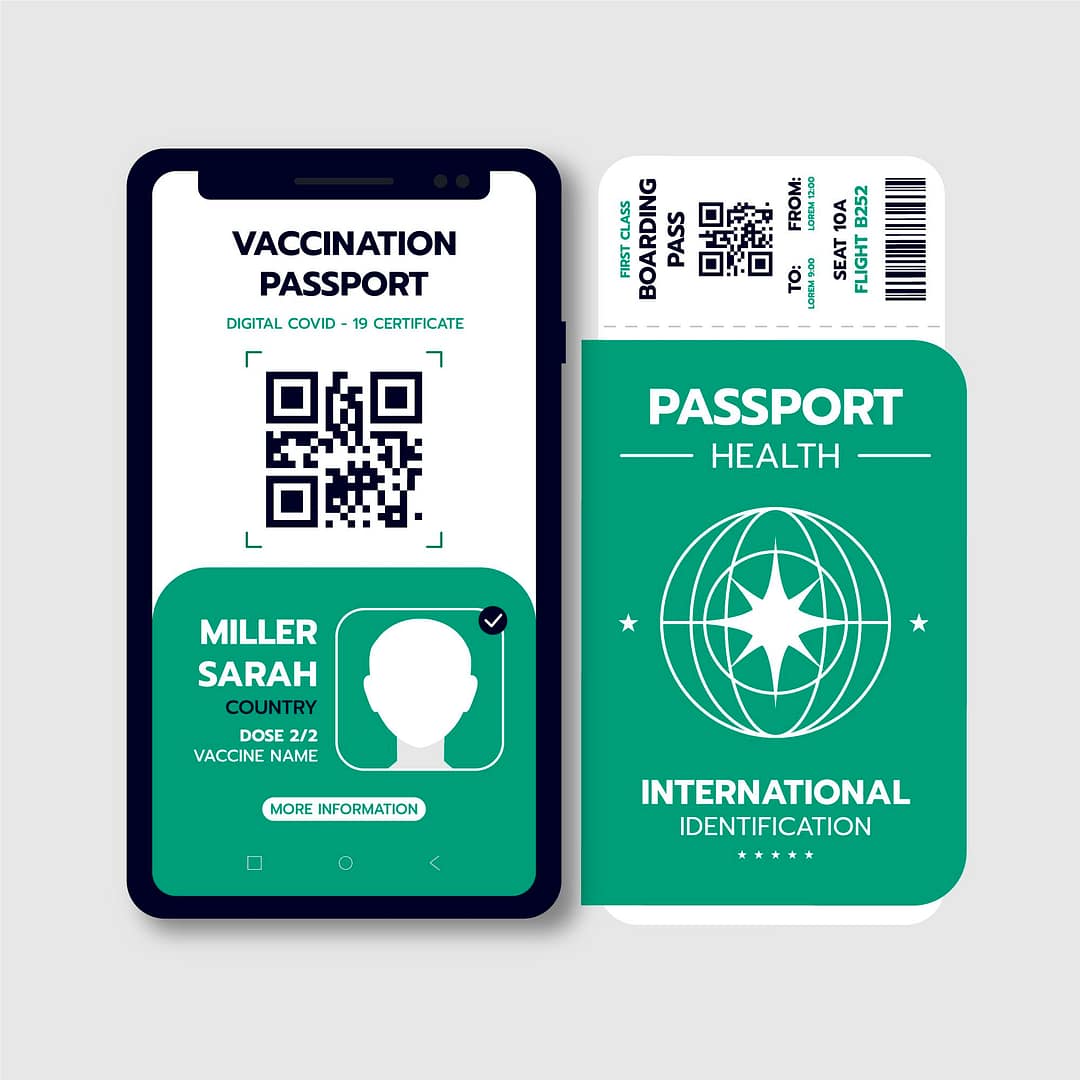
مرحباً بكم في العصر الجديد للسفر الجوي
تخيل أنك تدخل مطارًا، وتفحص وجهك للحظة، وتمر بسرعة عبر إجراءات تسجيل الوصول، والأمن، والصعود إلى الطائرة - لا عناء في التعامل مع المستندات، ولا طوابير انتظار طويلة، ولا توتر. لم يعد هذا حلمًا مستقبليًا. إنه يحدث بالفعل، بفضل جوازات السفر البيومترية وبطاقة هوية الوجه الأنظمة التي تعمل على تحويل طريقة عمل المطارات.
في هذه المقالة، سأوضح لك كيف تعمل هذه التقنيات على تسريع المطارات حول العالم، وما يحدث بالفعل خلف الكواليس، والتجارب الحقيقية للمسافرين الدائمين، وما يعنيه هذا بالنسبة لك كمسافر أو مالك عمل في صناعة السفر.
ما هي جوازات السفر البيومترية ومعرف الوجه بالضبط؟
قبل أن نتعمق في كيفية تزايد سرعة المطارات، دعونا نبدأ بالأساسيات.
A جواز السفر البيومترييُطلق عليه أحيانًا جواز السفر الإلكتروني، وهو يشبه جواز السفر العادي تمامًا، باستثناء تحسين رئيسي واحد: فهو مزود بشريحة مدمجة تخزن معلوماتك البيومترية بأمان. عادةً، تتضمن هذه المعلومات صورة وجهك، وأحيانًا بصمات أصابعك أو بيانات قزحية العين.
معرف الوجه, من ناحية أخرى، يستخدم نظام تحديد الهوية كاميرات وبرامج تمييز لمطابقة وجهك الحقيقي مع الصورة الرقمية المخزنة على شريحة جواز سفرك. يتيح هذا لأنظمة الحدود التحقق من هويتك فورًا، دون الحاجة إلى فحص مستنداتك يدويًا.
أتذكر أول مرة استخدمتُ فيها بوابة بيومترية في رحلة عبر أوروبا. كان الجميع في طوابير طويلة للفحص اليدوي، لكن صفي سار بسلاسة. وضعتُ جواز سفري على الماسح الضوئي، ونظرتُ إلى الكاميرا، وفي ثوانٍ فُتحت البوابة. لا أسئلة، لا انتظار. عندها أدركتُ مدى التغيير الجذري الذي تُحدثه هذه التكنولوجيا في المطارات.
لماذا تتبنى المطارات تقنية القياسات الحيوية بسرعة كبيرة؟
تواجه المطارات تحديًا هائلًا: تزايد أعداد المسافرين وضيق المساحة. يمر ملايين المسافرين عبر المطارات الرئيسية شهريًا، لذا فإن إدارة هذا التدفق بكفاءة أمر بالغ الأهمية.
وهنا السبب جوازات السفر البيومترية وبطاقة هوية الوجه هم من يغيرون قواعد اللعبة:
- السرعة والكفاءة ما كان يستغرق بضع دقائق لكل راكب، أصبح يستغرق ثوانٍ فقط. أصبحت الطوابير أسرع، ويقضي الناس وقتًا أقل في الوقوف في الطوابير.
- تقليل الخطأ البشري لا تتعب الآلات أو تشتت انتباهها. تستطيع الأنظمة الآلية تحديد هوية المسافرين بدقة أكبر من عمليات التحقق اليدوية من الهوية.
- أمان أفضل التحقق البيومتري يُصعّب عملية تزوير الهوية بشكل كبير. يتحقق النظام من تطابق صورتك الحية مع البيانات المشفرة في جواز سفرك.
- تحسين تجربة المسافر لا أحد يستمتع بطوابير الانتظار الطويلة في المطارات. فقصر أوقات الانتظار يعني مسافرين أكثر سعادةً ورحلات ربط أكثر سلاسة.
- المدخرات التشغيلية – توفر المطارات وشركات الطيران الأموال من خلال أتمتة أجزاء من العملية، مما يقلل الحاجة إلى زيادة عدد الموظفين عند نقاط التفتيش.
من منظور العمليات، تستوعب المطارات عددًا أكبر من المسافرين دون الحاجة إلى توسعة مباني المسافرين. أما من وجهة نظر المسافر، فهي ببساطة رحلة أسرع وأكثر راحة.
كيف تعمل التكنولوجيا خطوة بخطوة
إليك كيف تسير رحلتك عادةً عندما تكون الأنظمة البيومترية قيد التشغيل:
- تسجيل الوصول والتحقق
عند تسجيل وصولك عبر الإنترنت أو في أحد أكشاك الخدمة الذاتية، يتم مسح وجهك (أو ربطه بصورة جواز سفرك). يربط النظام هذا الملف البيومتري بتفاصيل رحلتك. - الأمن واستبدال بطاقة الصعود إلى الطائرة
عند نقاط التفتيش، يُغني التعرّف على الوجه عن فحص الهوية يدويًا. حتى أن بعض شركات الطيران تسمح لك بتخطي طباعة بطاقة الصعود تمامًا، إذ يصبح وجهك بمثابة بطاقة صعودك. - مراقبة الهجرة
تقوم البوابات الإلكترونية الآلية بقراءة الشريحة الموجودة داخل جواز سفرك البيومتري، ومطابقتها مع وجهك في الوقت الفعلي، وتأكيد هويتك خلال ثوانٍ. - الصعود إلى الطائرة
عند صعودك إلى الطائرة، تُتحقق هويتك وتفاصيل رحلتك من خلال نظرة سريعة على الكاميرا. لا داعي لإظهار وثائقك مرة أخرى.
خلال إحدى رحلاتي الأخيرة، استخدمتُ ممرًا بيومتريًا آليًا بالكامل، من تسجيل الوصول إلى الصعود إلى الطائرة. كانت العملية سلسة للغاية، لدرجة أنني بالكاد تفاعلتُ مع الموظفين حتى صعدتُ إلى الطائرة. استغرقت التجربة بأكملها، من دخول المطار إلى الجلوس في مقعدي، أقل من ٢٠ دقيقة.
أمثلة عالمية للمطارات البيومترية
في جميع أنحاء العالم، تتجه المزيد من المطارات إلى الأنظمة البيومترية لمواكبة الطلب من الركاب وتحسين كفاءة السفر.
- مطار شانغي سنغافورة اختبار تجربة بدون تلامس بالكامل - لا حاجة إلى بطاقات صعود إلى الطائرة أو جوازات سفر بمجرد التسجيل.
- مطاري هيثرو وفرانكفورت تم تركيب بوابات التعرف على الوجه للمسافرين من الاتحاد الأوروبي والمسافرين الدوليين المختارين.
- مطارات أتلانتا ولوس أنجلوس ودبي الدولية استخدم خاصية التعرف على الوجه لكل من المغادرة والوصول، مما يقلل أوقات الصعود إلى الطائرة بشكل كبير.
حتى في المطارات الصغيرة، تُطبّق أنظمة جزئية. بمجرد أن تصبح بعض نقاط التفتيش بيومترية، تبدأ الاختناقات بالاختفاء.
بالنسبة لشركات السفر، هذا يعني إعادة النظر في جداول المطارات وعمليات النقل. إذا تمكن العملاء من التنقل بشكل أسرع عبر نقاط التفتيش، ستصبح مسارات الرحلات أكثر مرونة وأقل إرهاقًا.
الخصوصية والثقة: ماذا عن أمن البيانات؟
كلما استخدمت تقنية جديدة مسحًا ضوئيًا لوجوهنا، تترتب على ذلك مخاوف تتعلق بالخصوصية. وهذا أمرٌ مشروع. بياناتك البيومترية حساسة، ويريد المسافرون التأكد من أمانها.
هكذا تتعامل معظم المطارات مع الأمر:
- لا يتم تخزين بيانات وجهك بشكل دائم؛ بل يتم حذفها بعد فترة وجيزة من رحلتك أو بعد تأكيد هويتك.
- يتم تشفير البيانات واستخدامها للتحقق فقط وليس للتسويق أو التتبع.
- يتعين على المسافرين عادةً الحصول على الموافقة قبل استخدام المسارات البيومترية.
مع ذلك، يبقى الوعي مهمًا. إذا لم تكن مرتاحًا للإجراءات، فإن معظم المطارات تسمح لك باختيار فحص المستندات التقليدي.
من وجهة نظري الشخصية، كنتُ مترددًا بشأن تقنية التعرف على الوجه أيضًا. ولكن بعد أن رأيتُ مدى صرامة وتأمين هذه العملية - خاصةً مقارنةً بتسليم المستندات عدة مرات - وجدتُها أقل تدخلاً مما توقعتُ.
الفوائد تتجاوز مجرد السرعة
في حين تركز معظم العناوين الرئيسية على "توفير الوقت"، فإن تأثير جوازات السفر البيومترية وتقنية التعرف على الوجه أعمق من ذلك بكثير:
- ورق أقل، استدامة أكبر - يؤدي تقليل عدد بطاقات الصعود والنماذج المطبوعة إلى تقليل النفايات.
- إمكانية الوصول – يجد المسافرون الذين يواجهون صعوبات في التعامل مع الحواجز اللغوية أو فقدان الوثائق أنه من الأسهل المرور عبر الأنظمة الآلية.
- تعزيز السلامة – تعمل عملية التحقق بدون لمس على تقليل الاتصال الجسدي، والذي أصبح عاملاً رئيسياً أثناء وبعد الوباء.
- رؤى البيانات الأكثر ذكاءً - يمكن للمطارات استخدام البيانات مجهولة المصدر للتخطيط بشكل أفضل للسيطرة على الحشود وتوظيف الموظفين، مما يؤدي إلى تحسين الكفاءة بشكل عام.
عندما تفكر في الأمر، قد يبدو مطار المستقبل أشبه بردهة فندق عالي التقنية - آلي وسريع، ولكنه في الوقت نفسه شخصي بشكل مدهش.
ما هو التالي في السفر الجوي البيومتري؟
من المتوقع مستقبلًا أن تتوسع جوازات السفر البيومترية وتقنية التعرف على الوجه لتتجاوز المطارات. قريبًا، قد يكون وجهك مفتاح سفرك من المنزل إلى الفندق.
- محافظ الهوية الرقمية سيسمح لك بالتحقق من هويتك عبر شركات الطيران والهجرة وحتى الفنادق.
- ممرات سفر سلسة سيربط الأنظمة الدولية، مما يعني أن عملية مسح واحدة قد تمكنك من عبور حدود متعددة.
- التكامل مع التطبيقات سيسمح للمسافرين بالتسجيل عن بعد قبل وصولهم إلى المطار.
بالنسبة للمسافرين الدائمين ووكالات السفر، يُعد فهم كيفية تطور هذه التقنية أمرًا بالغ الأهمية. وقد تصبح معرفة المطارات التي تقدم خدمات القياسات الحيوية بنفس أهمية معرفة الرحلات المباشرة.












